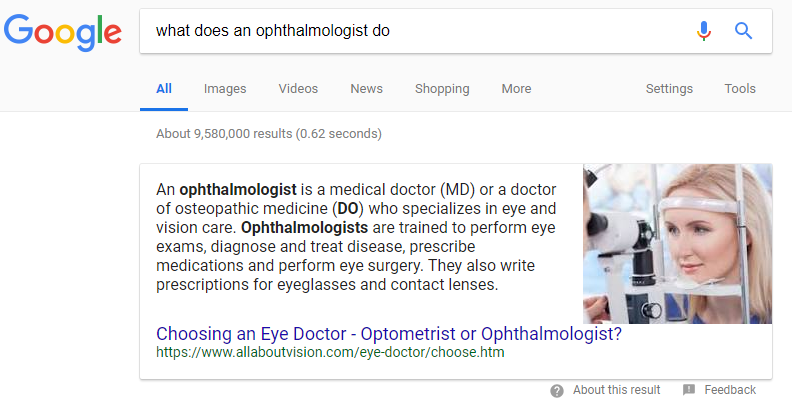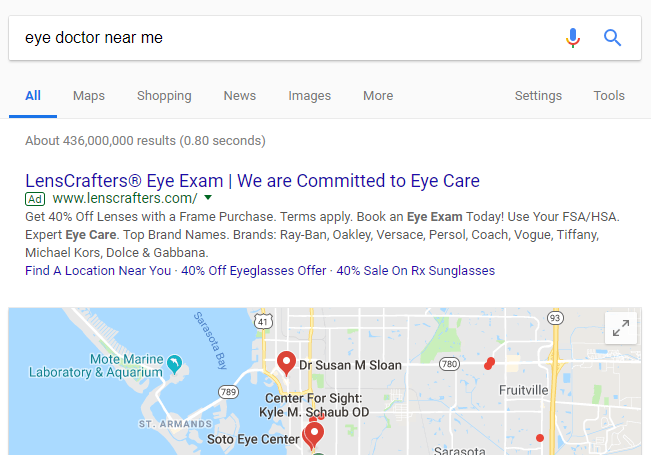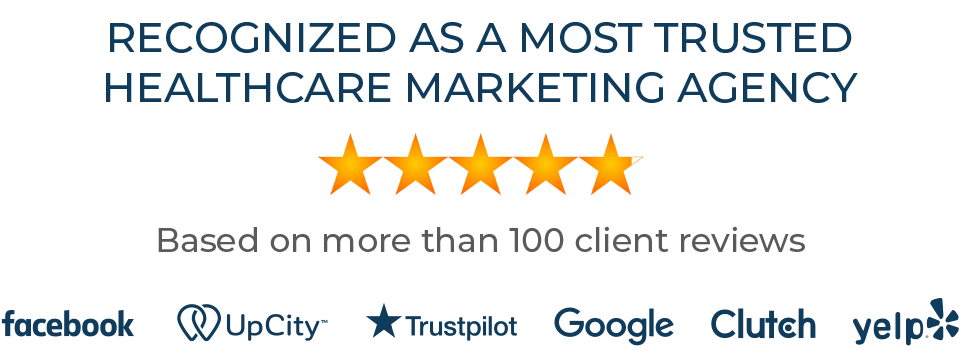Marketing is changing. It always is, but there’s a definitive shift in where the attention of our consumers is spent these days, and nearly every industry is affected.
As Gary Vaynerchuk often spouts, “any time there’s a major shift in consumer attention, a lot of money is made, and a lot of money is lost.”
Today, we see less and less money spent on radio, print, and even television commercials, as our end consumer spends more time fast forwarding through commercials, and less time picking up a newspaper or magazine.
The world is digital, and consumers want information and answers immediately. They have a need, and grab their mobile device, ipad or tablet, and search for solutions or services. And in that micro-moment of searching, business is won and lost before you even get a chance to sit with a potential client, customer, or patient.
One of the biggest issues in healthcare is the upcoming patient demographic change because of the aging baby boomer generation. We’re seeing more patients turn to mobile devices as the target demographic has changed from one that was brought up to use the phone book, into consumers who are more comfortable using mobile devices.
Because of this, niche industries like ophthalmology are turning to more digital marketing strategies to stay ahead of their competition, but it’s unlike digital marketing for attorneys or even dentists.
Everyone knows that when they have a workers comp issue they call a workers compensation attorney. Or when they have a toothache they call the dentist. For Ophthalmologists and eye care professionals, there’s a need to educate the market and to gain trust and authority long before the initial exam.
With that in mind, here are 12 ways that Opthamologists and eye care doctors can reach an increasingly digital audience, and convert more searchers into patients:
Building Relationships
The senior consumer market is still dominated by relationships, trust and referrals. Although search engine marketing remains a marketing staple to gain exposure, relationship-building platforms, specifically social media and email, continue to have increasing impact.

More than one in three seniors not only indicate they use social media, but they are comfortable and confident with it.
This growing online population is also dominated by female seniors, who incidentally drive most family health choices.
The key is to not simply post on your social media, but to also engage and conduct outreach.
Boosting Online Reviews
If there is one thing that rivals your value proposition in importance, it’s your online reputation.
Today, consumers look to online reviews as an important way to evaluate services. There is an inherent trust level in the words of fellow consumers, and an insight that can only be gained from their perspective.
Of course, those words are not always wise – or even fair. Which is why you need to manage your reputation as much as possible.

It starts with your service. Superb customer service needs to be a mandate at your office. Know that every time you cut corners or fail to meet expectations, it can have lasting repercussions on your marketing.
The same is true when you delight people and exceed expectations.
The best way to improve your review profile is to ask happy clients to leave you a review – a simple but often overlooked step. Do this in person right at the moment a patient is delighted with their improved vision.
You can also use a follow-up email with a link to the review profile you want to build.
Monitor and respond to reviews on Google My Business, BBB, Facebook, and Yelp. If you get a negative review, respond and rectify the situation as quickly and professionally as possible.
If you’re getting a lot of positive reviews, turn on the review feature on Facebook.
Social Education
What’s the difference between a diagnostic eye exam and an exam for the purposes of refraction? At what age should I begin having my children’s eyes checked?
Potential patients are looking for answers and you can use Facebook and YouTube to educate them. When they find solutions to their concerns, they’re going to build trust with the doctor that’s providing the answer – you.
Content Marketing
Content marketing is a way to promote your company or practice through digital media in a very educational way.
Examples of content marketing include blogging, video distribution, YouTube channels, white paper reports, social media marketing and more.
This type of published marketing differs from traditional marketing and cold calling because it is designed to bring customers in that are asking questions instead of interrupting and broadcasting.
Content marketing techniques are used to reach customers at varying levels in their decision making process and helps to educate and assist them with their best purchasing decisions.
Today’s buyers do a lot more independent research, read more reviews and listen more intently to what their friends have to say.
Think of it this way – If a person is having some vision difficulty, they may not be noticing that one of their eyes is turning in. All they may recognize is that they can’t see as well as did a year ago.
A written article speaking to the causes of this vision difficulty, or a video identifying some of the difficulties a consumer is having, speaks a solution to that viewer/reader.
And, when they start finding solutions from a trusted opthamologist, they’re going to pick up the phone and schedule a visit.
Social Media Targeting
Facebook has a plethora or targeting capabilities, but using it to reach a user that’s having vision issues might be tough.
Instead, use Facebook’s address targeting to place content about your practice in front of physicians who might refer their patients to you directly.
Here’s how you do this:
Create a list of physicians addresses. Local clinics, family practices, and the link, and bulk upload these addresses to Facebook. Change the default radius to 1 mile (this might be set to 10 miles by default).
Select that you want to target users who are at or were recently at the locations you’ve selected.

Now, under demographics, select only users that are identified as doctors or physicians. You might also want to add in Facebook page Admins to target office managers of those practices.

Give your new audience a name, something like “local doc’s” or “practices nearby.”

That’s it! Now, doctors and page admins within those addresses are going to see the ads and posts that you boost using Facebook’s paid advertising.
When you add a post you need them to see, click the Boost Post option on the post and select your newly created audience. For a few bucks, you’re reaching a targeted base that can refer their patients to your practice.
Search Engine Optimization
Website optimization is a process of refining websites for better user experience, boosting search engine traffic and most importantly improving business.
You’ll see a huge boost in search engine rankings just by following the tips in this article.
In addition to these, you’ll need to make sure your website is optimized properly so that is performs at its absolute best for your business.

Is your website properly optimized?
Optimizing your website can take time depending on how many pages are currently on your site, and the industry keywords your looking to rank for. There are tools to help you, too – like Optimizely, and Yoast SEO (For WordPress websites).
Here are a few things you need to ensure are optimized properly:
- Create unique and accurate page titles
- Make use of the “description” meta tag’
- Improve the Structure of Your URLs
- Make Your Site Navigation Easier
- Optimize Your website for Mobile Phones
The last of these listed is one of the most important. Your website must be mobile responsive to be favored by Google, and to be easy to navigate by your visitors. If you’re unsure if your website is mobile responsive, use Google’s free Mobile test, here:
Voice Search Marketing
When mobile started to become the mainstay in consumer searches, we began to slowly see mobile device search overtaking desktop searches. It took a couple of years, but today, mobile search dominates Google and Bing searches by far.
We see a similar trend with voice search. Users are slowly beginning to search more and more with their voice assistants like Siri, Alexa, and Google Home.
It’s predicted that by 2020, more than 50% of all searches will be voice based, which is an even faster trend than what we saw with mobile searches.
[easy-tweet tweet=” It’s predicted that by 2020, more than 50% of all searches will be voice based” via=”no” usehashtags=”no”]While it’s still a couple of years away, your practice needs to be prepared for this. You can do this by starting now, and adding content that will answer questions and provide solutions to Google searchers.
- Use Rich Snippets
- Answer Questions
- Be Mobile Responsive
Have you ever searched a question and found that the answer was provided on the Google search screen like this?

We call this “position 0” and the reason for that is that the answer to the question is above any Adwords Ads, and even above the organic listings.
Getting your page to rank here takes a lot of time and effort, but you can slowly begin the process by answering common questions in the content you’re adding.
Think “why is one of my eyes lazy?” Or “what kind of doctor can give me a vision test?” Adding content that speaks to these questions will help your practice to reach position 0 for questions and keyword searches.
Pay Per Click Marketing
Depending on your region, Pay-Per-Click marketing can be a great tool for advertising your services directly to potential patients. Google recently changed the name of this service to Google Ads, but it’s the same premise as it always has been.
Searchers type into the search engine and depending on your budget and bidding strategies, your link appears above the organic listings, like this:

Pay-Per-Click marketing can get a bit expensive over time, and it’s not really sustainable. If you stop paying tomorrow, your ads disappear. So it’s important to keep a close eye on your spending as the campaign moves forward.
It many cases, it’s best to partner with a digital marketing agency that can manage this type of campaign on a day-to-day basis.
Video Marketing
Is there a trick to help me add drops to my eyes with ease? Are there certain things I need to remember to do or look for after surgery?
These are examples of great ideas your doctors can talk about in quick videos that you can distribute on your website, Facebook, YouTube, and Instagram.

Before & After Videos
Case studies and before and after videos are fantastic ways to publicize some of the great work your practice is doing. You’ll of course need a patient’s permission but, finding 2-3 to let you film part of their journey to finding a solution is great content to add via your social channels.
Video Testimonials
Consumers trust reviews. The main goal of a testimonial is to help build trust with your prospective patients.
According to Bright Local, 88% of people trust online reviews written by other consumers.
However, there are some sneaky individuals out there who will write positive testimonial reviews and publish them online, when they never have used the business’s services before.
Consumers are now becoming wise to this and now are starting to question any and all written reviews.
This is where video testimonials are more beneficial. Videos allow for your clients to see the real live reviewer. By seeing the reviewer, the consumer is able to build trust in your practice and believe in what you have to offer. After all, seeing is believing.
It’s not difficult or even expensive to begin adding video testimonials. In fact, we recently wrote an article on how to start video marketing without spending thousands of dollars that will help you even more.
But, an easy explanation is to setup the camera (even the iPhone camera), pick an exam room that’s available and well lit, and hit record! Ask your patient pointed questions like “why did you come to us?” Or “what solutions were we able to provide you?”
Here are even more questions you can ask a patient who is reviewing your practice.
Patient Attrition
In the daily hustle of life it can be very easy for patients to forget or miss necessary visits. It is critical to ensure that patients are regularly notified of upcoming visits to ensure that they don’t miss visit windows or other critical information that would require them to leave the study.
This should be done via multiple mediums to ensure that patients see the notifications. Using a combination of printed and digital reminders is very effective.
Tools like MailChimp and Constant Contact enable businesses to setup automatic reminders that they can send to patients when visits are upcoming. It’s a also a great way to stay connected, which always helps to keep patients with your practice.
Conclusion
Practices that are earlier in the digital marketing process may feel a bit overwhelmed. But the most valuable advice I can offer: Don’t be frozen by indecision — take action!
Start by identifying the type of patients you want to attract and then determine the pace you want to, or are able to, grow. This can help you establish a realistic budget to start building your digital marketing campaigns. It will also allow you to identify the type of image or brand messaging you want to project and the digital channels to select.
One other piece of advice I suggest is to start inside and work your way out. What I mean here is to assess your, your team’s and your practice’s ability and processes to grow. Build an Internet marketing campaign around your most accessible and valued audience — your patients, referrers, contacts and people you know.
Keep in mind, effective Internet marketing is less about advertising and more about building and expanding your online community and brand.
Marketing is changing. It always is, but there’s a definitive shift in where the attention of our consumers is spent these days, and nearly every industry is affected.
As Gary Vaynerchuk often spouts, “any time there’s a major shift in consumer attention, a lot of money is made, and a lot of money is lost.”
Today, we see less and less money spent on radio, print, and even television commercials, as our end consumer spends more time fast forwarding through commercials, and less time picking up a newspaper or magazine.
The world is digital, and consumers want information and answers immediately. They have a need, and grab their mobile device, ipad or tablet, and search for solutions or services. And in that micro-moment of searching, business is won and lost before you even get a chance to sit with a potential client, customer, or patient.
One of the biggest issues in healthcare is the upcoming patient demographic change because of the aging baby boomer generation. We’re seeing more patients turn to mobile devices as the target demographic has changed from one that was brought up to use the phone book, into consumers who are more comfortable using mobile devices.
Because of this, niche industries like ophthalmology are turning to more digital marketing strategies to stay ahead of their competition, but it’s unlike digital marketing for attorneys or even dentists.
Everyone knows that when they have a workers comp issue they call a workers compensation attorney. Or when they have a toothache they call the dentist. For Ophthalmologists and eye care professionals, there’s a need to educate the market and to gain trust and authority long before the initial exam.
With that in mind, here are 12 ways that Opthamologists and eye care doctors can reach an increasingly digital audience, and convert more searchers into patients:
Building Relationships
The senior consumer market is still dominated by relationships, trust and referrals. Although search engine marketing remains a marketing staple to gain exposure, relationship-building platforms, specifically social media and email, continue to have increasing impact.

More than one in three seniors not only indicate they use social media, but they are comfortable and confident with it.
This growing online population is also dominated by female seniors, who incidentally drive most family health choices.
The key is to not simply post on your social media, but to also engage and conduct outreach.
Boosting Online Reviews
If there is one thing that rivals your value proposition in importance, it’s your online reputation.
Today, consumers look to online reviews as an important way to evaluate services. There is an inherent trust level in the words of fellow consumers, and an insight that can only be gained from their perspective.
Of course, those words are not always wise – or even fair. Which is why you need to manage your reputation as much as possible.

It starts with your service. Superb customer service needs to be a mandate at your office. Know that every time you cut corners or fail to meet expectations, it can have lasting repercussions on your marketing.
The same is true when you delight people and exceed expectations.
The best way to improve your review profile is to ask happy clients to leave you a review – a simple but often overlooked step. Do this in person right at the moment a patient is delighted with their improved vision.
You can also use a follow-up email with a link to the review profile you want to build.
Monitor and respond to reviews on Google My Business, BBB, Facebook, and Yelp. If you get a negative review, respond and rectify the situation as quickly and professionally as possible.
If you’re getting a lot of positive reviews, turn on the review feature on Facebook.
Social Education
What’s the difference between a diagnostic eye exam and an exam for the purposes of refraction? At what age should I begin having my children’s eyes checked?
Potential patients are looking for answers and you can use Facebook and YouTube to educate them. When they find solutions to their concerns, they’re going to build trust with the doctor that’s providing the answer – you.
Content Marketing
Content marketing is a way to promote your company or practice through digital media in a very educational way.
Examples of content marketing include blogging, video distribution, YouTube channels, white paper reports, social media marketing and more.
This type of published marketing differs from traditional marketing and cold calling because it is designed to bring customers in that are asking questions instead of interrupting and broadcasting.
Content marketing techniques are used to reach customers at varying levels in their decision making process and helps to educate and assist them with their best purchasing decisions.
Today’s buyers do a lot more independent research, read more reviews and listen more intently to what their friends have to say.
Think of it this way – If a person is having some vision difficulty, they may not be noticing that one of their eyes is turning in. All they may recognize is that they can’t see as well as did a year ago.
A written article speaking to the causes of this vision difficulty, or a video identifying some of the difficulties a consumer is having, speaks a solution to that viewer/reader.
And, when they start finding solutions from a trusted opthamologist, they’re going to pick up the phone and schedule a visit.
Social Media Targeting
Facebook has a plethora or targeting capabilities, but using it to reach a user that’s having vision issues might be tough.
Instead, use Facebook’s address targeting to place content about your practice in front of physicians who might refer their patients to you directly.
Here’s how you do this:
Create a list of physicians addresses. Local clinics, family practices, and the link, and bulk upload these addresses to Facebook. Change the default radius to 1 mile (this might be set to 10 miles by default).
Select that you want to target users who are at or were recently at the locations you’ve selected.

Now, under demographics, select only users that are identified as doctors or physicians. You might also want to add in Facebook page Admins to target office managers of those practices.

Give your new audience a name, something like “local doc’s” or “practices nearby.”

That’s it! Now, doctors and page admins within those addresses are going to see the ads and posts that you boost using Facebook’s paid advertising.
When you add a post you need them to see, click the Boost Post option on the post and select your newly created audience. For a few bucks, you’re reaching a targeted base that can refer their patients to your practice.
Search Engine Optimization
Website optimization is a process of refining websites for better user experience, boosting search engine traffic and most importantly improving business.
You’ll see a huge boost in search engine rankings just by following the tips in this article.
In addition to these, you’ll need to make sure your website is optimized properly so that is performs at its absolute best for your business.

Is your website properly optimized?
Optimizing your website can take time depending on how many pages are currently on your site, and the industry keywords your looking to rank for. There are tools to help you, too – like Optimizely, and Yoast SEO (For WordPress websites).
Here are a few things you need to ensure are optimized properly:
- Create unique and accurate page titles
- Make use of the “description” meta tag’
- Improve the Structure of Your URLs
- Make Your Site Navigation Easier
- Optimize Your website for Mobile Phones
The last of these listed is one of the most important. Your website must be mobile responsive to be favored by Google, and to be easy to navigate by your visitors. If you’re unsure if your website is mobile responsive, use Google’s free Mobile test, here:
Voice Search Marketing
When mobile started to become the mainstay in consumer searches, we began to slowly see mobile device search overtaking desktop searches. It took a couple of years, but today, mobile search dominates Google and Bing searches by far.
We see a similar trend with voice search. Users are slowly beginning to search more and more with their voice assistants like Siri, Alexa, and Google Home.
It’s predicted that by 2020, more than 50% of all searches will be voice based, which is an even faster trend than what we saw with mobile searches.
[easy-tweet tweet=” It’s predicted that by 2020, more than 50% of all searches will be voice based” via=”no” usehashtags=”no”]While it’s still a couple of years away, your practice needs to be prepared for this. You can do this by starting now, and adding content that will answer questions and provide solutions to Google searchers.
- Use Rich Snippets
- Answer Questions
- Be Mobile Responsive
Have you ever searched a question and found that the answer was provided on the Google search screen like this?

We call this “position 0” and the reason for that is that the answer to the question is above any Adwords Ads, and even above the organic listings.
Getting your page to rank here takes a lot of time and effort, but you can slowly begin the process by answering common questions in the content you’re adding.
Think “why is one of my eyes lazy?” Or “what kind of doctor can give me a vision test?” Adding content that speaks to these questions will help your practice to reach position 0 for questions and keyword searches.
Pay Per Click Marketing
Depending on your region, Pay-Per-Click marketing can be a great tool for advertising your services directly to potential patients. Google recently changed the name of this service to Google Ads, but it’s the same premise as it always has been.
Searchers type into the search engine and depending on your budget and bidding strategies, your link appears above the organic listings, like this:

Pay-Per-Click marketing can get a bit expensive over time, and it’s not really sustainable. If you stop paying tomorrow, your ads disappear. So it’s important to keep a close eye on your spending as the campaign moves forward.
It many cases, it’s best to partner with a digital marketing agency that can manage this type of campaign on a day-to-day basis.
Video Marketing
Is there a trick to help me add drops to my eyes with ease? Are there certain things I need to remember to do or look for after surgery?
These are examples of great ideas your doctors can talk about in quick videos that you can distribute on your website, Facebook, YouTube, and Instagram.

Before & After Videos
Case studies and before and after videos are fantastic ways to publicize some of the great work your practice is doing. You’ll of course need a patient’s permission but, finding 2-3 to let you film part of their journey to finding a solution is great content to add via your social channels.
Video Testimonials
Consumers trust reviews. The main goal of a testimonial is to help build trust with your prospective patients.
According to Bright Local, 88% of people trust online reviews written by other consumers.
However, there are some sneaky individuals out there who will write positive testimonial reviews and publish them online, when they never have used the business’s services before.
Consumers are now becoming wise to this and now are starting to question any and all written reviews.
This is where video testimonials are more beneficial. Videos allow for your clients to see the real live reviewer. By seeing the reviewer, the consumer is able to build trust in your practice and believe in what you have to offer. After all, seeing is believing.
It’s not difficult or even expensive to begin adding video testimonials. In fact, we recently wrote an article on how to start video marketing without spending thousands of dollars that will help you even more.
But, an easy explanation is to setup the camera (even the iPhone camera), pick an exam room that’s available and well lit, and hit record! Ask your patient pointed questions like “why did you come to us?” Or “what solutions were we able to provide you?”
Here are even more questions you can ask a patient who is reviewing your practice.
Patient Attrition
In the daily hustle of life it can be very easy for patients to forget or miss necessary visits. It is critical to ensure that patients are regularly notified of upcoming visits to ensure that they don’t miss visit windows or other critical information that would require them to leave the study.
This should be done via multiple mediums to ensure that patients see the notifications. Using a combination of printed and digital reminders is very effective.
Tools like MailChimp and Constant Contact enable businesses to setup automatic reminders that they can send to patients when visits are upcoming. It’s a also a great way to stay connected, which always helps to keep patients with your practice.
Conclusion
Practices that are earlier in the digital marketing process may feel a bit overwhelmed. But the most valuable advice I can offer: Don’t be frozen by indecision — take action!
Start by identifying the type of patients you want to attract and then determine the pace you want to, or are able to, grow. This can help you establish a realistic budget to start building your digital marketing campaigns. It will also allow you to identify the type of image or brand messaging you want to project and the digital channels to select.
One other piece of advice I suggest is to start inside and work your way out. What I mean here is to assess your, your team’s and your practice’s ability and processes to grow. Build an Internet marketing campaign around your most accessible and valued audience — your patients, referrers, contacts and people you know.
Keep in mind, effective Internet marketing is less about advertising and more about building and expanding your online community and brand.
Published on July 10, 2018

